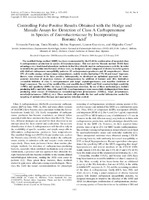Please use this identifier to cite or link to this item:
http://sgc.anlis.gob.ar/handle/123456789/269| DC Field | Value | Language |
|---|---|---|
| dc.contributor.author | Pasteran, Fernando | - |
| dc.contributor.author | Mendez, Tania | - |
| dc.contributor.author | Rapoport, Melina J. | - |
| dc.contributor.author | Guerriero, Leonor | - |
| dc.contributor.author | Corso, Alejandra | - |
| dc.date.accessioned | 2012-10-25T01:25:24Z | - |
| dc.date.available | 2012-10-25T01:25:24Z | - |
| dc.date.issued | 2010 | |
| dc.identifier.issn | 1098-660X | |
| dc.identifier.uri | http://jcm.asm.org/content/48/4/1323.full.pdf+html | - |
| dc.identifier.uri | http://sgc.anlis.gob.ar/handle/123456789/269 | - |
| dc.description | The modified Hodge method (MHT) has been recommended by the CLSI for confirmation of suspected class A carbapenemase production in species of Enterobacteriaceae. This test and the Masuda method (MAS) have advantages over traditional phenotypic methods in that they directly analyze carbapenemase activity. In order to identify the potential interferences of these tests, we designed a panel composed of diverse bacterial genera with distinct carbapenem susceptibility patterns (42 carbapenemase producers and 48 nonproducers). About 25% of results among carbapenemase nonproducers, mainly strains harboring CTX-M and AmpC hyperproducers, were observed to be false positive. Subsequently, we developed an optimized approach for moreaccurate detection of suspicious isolates of carbapenemase by addition of boronic acid (BA) derivatives (reversible inhibitor of class A carbapenemases and AmpC cephalosporinases) and oxacillin (inhibitor of AmpCs enzymes). The use of the modified BA- and oxacillin-based MHT and MAS resulted in high sensitivity (>90%) and specificity (100%) for class A carbapenemase detection. By use of these methodologies, isolates producing KPCs and GES, Sme, IMI, and NMC-A carbapenemases were successfully distinguished from those producing other classes of ß-lactamases (extended-spectrum -lactamases [ESBLs], AmpC -lactamases, metallo- -lactamases [MBLs], etc.). These methods will provide the fast and useful information needed for targeting of antimicrobial therapy and appropriate infection control. | ES |
| dc.description | Fil: Pasteran, Fernando. ANLIS Dr.C.G.Malbrán. Instituto Nacional de Enfermedades Infecciosas. Departamento de Bacteriología. Servicio de Antimicrobianos; Argentina. | ES |
| dc.description | Fil: Mendez, Tania. ANLIS Dr.C.G.Malbrán. Instituto Nacional de Enfermedades Infecciosas. Departamento de Bacteriología. Servicio de Antimicrobianos; Argentina. | ES |
| dc.description | Fil: Rapoport, Melina J. ANLIS Dr.C.G.Malbrán. Instituto Nacional de Enfermedades Infecciosas. Departamento de Bacteriología. Servicio de Antimicrobianos; Argentina. | ES |
| dc.description | Fil: Guerriero, Leonor. ANLIS Dr.C.G.Malbrán. Instituto Nacional de Enfermedades Infecciosas. Departamento de Bacteriología. Servicio de Antimicrobianos; Argentina. | ES |
| dc.description | Fil: Corso, Alejandra. ANLIS Dr.C.G.Malbrán. Instituto Nacional de Enfermedades Infecciosas. Departamento de Bacteriología. Servicio de Antimicrobianos; Argentina. | ES |
| dc.format | application/pdf | ES |
| dc.language.iso | eng | en_US |
| dc.rights | info:eu-repo/semantics/openAccess | en_US |
| dc.source | Journal of Clinical Microbiology, 2010, 48(4), 1323–1332. | en_US |
| dc.subject | Enterobacteriaceae | en_US |
| dc.subject | Reacciones Falso Positivas | en_US |
| dc.subject | Humanos | en_US |
| dc.subject | Ácidos Borónicos | en_US |
| dc.subject | Oxacilina | en_US |
| dc.title | Controlling false-positive results obtained with the Hodge and Masuda assays for detection of class a carbapenemase in species of enterobacteriaceae by incorporating boronic Acid | en_US |
| dc.type | Artículo | es |
| anlis.essnrd | 1 | es |
| item.fulltext | With Fulltext | - |
| item.openairetype | Artículo | - |
| item.cerifentitytype | Publications | - |
| item.languageiso639-1 | en | - |
| item.openairecristype | http://purl.org/coar/resource_type/c_18cf | - |
| item.grantfulltext | open | - |
| crisitem.author.dept | Servicio Antimicrobianos | - |
| crisitem.author.dept | Departamento de Bacteriología | - |
| crisitem.author.dept | Instituto Nacional de Enfermedades Infecciosas (INEI) | - |
| crisitem.author.dept | Administración Nacional de Laboratorios e Institutos de Salud “Dr. Carlos G. Malbrán” (ANLIS) | - |
| crisitem.author.dept | Servicio Antimicrobianos | - |
| crisitem.author.dept | Departamento de Bacteriología | - |
| crisitem.author.dept | Instituto Nacional de Enfermedades Infecciosas (INEI) | - |
| crisitem.author.dept | Administración Nacional de Laboratorios e Institutos de Salud “Dr. Carlos G. Malbrán” (ANLIS) | - |
| crisitem.author.dept | Administración Nacional de Laboratorios e Institutos de Salud “Dr. Carlos G. Malbrán” (ANLIS) | - |
| crisitem.author.dept | Instituto Nacional de Enfermedades Infecciosas (INEI) | - |
| crisitem.author.dept | Departamento de Bacteriología | - |
| crisitem.author.dept | Servicio Antimicrobianos | - |
| crisitem.author.orcid | 0000-0003-1183-6746 | - |
| crisitem.author.parentorg | Departamento de Bacteriología | - |
| crisitem.author.parentorg | Instituto Nacional de Enfermedades Infecciosas (INEI) | - |
| crisitem.author.parentorg | Administración Nacional de Laboratorios e Institutos de Salud “Dr. Carlos G. Malbrán” (ANLIS) | - |
| crisitem.author.parentorg | Departamento de Bacteriología | - |
| crisitem.author.parentorg | Instituto Nacional de Enfermedades Infecciosas (INEI) | - |
| crisitem.author.parentorg | Administración Nacional de Laboratorios e Institutos de Salud “Dr. Carlos G. Malbrán” (ANLIS) | - |
| crisitem.author.parentorg | Administración Nacional de Laboratorios e Institutos de Salud “Dr. Carlos G. Malbrán” (ANLIS) | - |
| crisitem.author.parentorg | Instituto Nacional de Enfermedades Infecciosas (INEI) | - |
| crisitem.author.parentorg | Departamento de Bacteriología | - |
| Appears in Collections: | snrd Publicaciones INEI | |
Files in This Item:
| File | Description | Size | Format | |
|---|---|---|---|---|
| JournalofClinicalMicrobiology,2010,48(4),1323–1332..pdf | 1.58 MB | Adobe PDF |  View/Open |
Page view(s)
215
checked on Dec 23, 2025
Download(s)
127
checked on Dec 23, 2025
Google ScholarTM
Check
Items in DSpace are protected by copyright, with all rights reserved, unless otherwise indicated.

